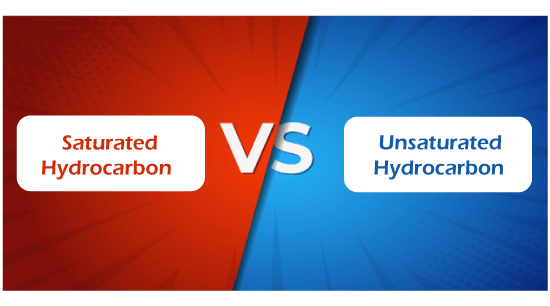Difference between Saturated and Unsaturated HydrocarbonChemistry is a vivid subject filled with bonds, compounds, chemical reactions, etc. These bonds and compounds give rise to ions, anions, cations, anodes, cathodes, etc. One of the major aspects of chemistry is the periodic table. In the periodic table, the atomic numbers and atomic masses are given through which a scientist can create certain chemicals. Today, we will be discussing about one of these bonds/ chemicals, i.e., saturated hydrocarbon and unsaturated hydrocarbon. Now, there are certain differences between the two terms. But one of the striking similarities between them is that both saturated and unsaturated hydrocarbons are organic compounds. So, apart from the differences, let us first look at the meanings of these two terms. 
Saturated HydrocarbonA saturated hydrocarbon is defined as a hydrocarbon that comprises of carbon-carbon bonds. All the carbon-carbon bonds are single bonds, i.e., they include hydrogen and atom only. In saturated hydrocarbons, the carbon is bonded with four to five saturated atoms so that multiple bonds are not formed. Since saturated hydrocarbon is an organic compound, multiple bonds cannot exist in it. It is interesting to note that saturated hydrocarbons are used as a reference for alkenes-acyclic hydrocarbons. The formula of an alkane is CnH2n+2. In this formula, propane is a saturated hydrocarbon bonded with the hydrogen atom. It is a single bond in which no more atoms can be bonded/ accommodated. Examples of saturated hydrocarbons include octane, cyclopropane, butane, cyclohexane, etc. Now, there are two significant types of saturated hydrocarbons, i.e., alkanes and cycloalkanes. It is interesting to note that some alkanes have ring structures that come under cycloalkanes (saturated hydrocarbons). Alkanes are the carbon chains in the structures. All the carbon atoms in alkanes are hybrid. The boiling and melting point of alkane depends upon the length of the carbon chain. If the length is more, the boiling/ melting point will be higher. Alkanes consist of four carbon atoms at standard temperatures. Alkanes comprising of more than three carbon atoms are capable of forming chain isomerism. On the other hand, cycloalkanes are ring structures containing hybridized atoms. The properties of cycloalkanes are similar to those of alkanes. Unlike alkanes, the melting/ boiling points of cycloalkanes are relatively higher. Both alkanes and cycolakanes share the same physical properties. Unsaturated HydrocarbonUnsaturated hydrocarbons are defined as carbons that consist of double/ triple covalent bonds. Unsaturated hydrocarbons mean that there is more level of hydrogen atoms in hydrocarbons to make them saturated. Unsaturated hydrocarbon is an organic compound containing hydrogen and carbon atoms. There are three significant kinds of unsaturated hydrocarbons, i.e., alkenes, alkynes, and aromatic. A double bond between two carbon atoms is called alkenes. Example of alkenes includes C2H4 (Ethene). A triple bond between two carbon atoms is called alkynes. Example of alkynes includes C2H2 (acetylene). Aromatic hydrocarbons are quite stable than the other two. These hydrocarbons do not share similar properties as that of alkenes or alkynes. Unsaturated hydrocarbons are subjected to many uses like:
Well, there are certain differences between saturated and unsaturated hydrocarbons. So, let us have a look at them.
So, these are some of the contrasting points regarding saturated and unsaturated hydrocarbons. Now, let us look at their properties. Properties/ Uses of Saturated Hydrocarbons
Properties/ Uses of Unsaturated Hydrocarbons
So, these are some of the properties/ uses of saturated and unsaturated hydrocarbons. Both hydrocarbons are organic compounds that are used in making other chemical compounds. A carbon chain is formed on which the melting and boiling point of the hydrocarbon depends. Thus, both saturated and unsaturated hydrocarbons are essential aspects of chemistry.
Next TopicDifference between
|
 For Videos Join Our Youtube Channel: Join Now
For Videos Join Our Youtube Channel: Join Now
Feedback
- Send your Feedback to [email protected]
Help Others, Please Share










